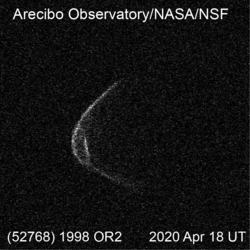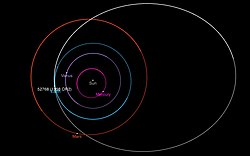(52768) 1998 OR2
 Radar image of 1998 OR2 taken by the Arecibo Observatory on 18 April 2020 | |
| Discovery[1][2] | |
|---|---|
| Discovered by | NEAT |
| Discovery site | Haleakala Obs. |
| Discovery date | 24 July 1998 |
| Designations | |
| (52768) 1998 OR2 | |
| 1998 OR2 | |
Minor planet category | Amor · NEO · PHA[1][2] |
| Orbital characteristics[1] | |
 | |
| Epoch 31 May 2020 (JD 2459000.5) | |
| Uncertainty parameter 0 | |
| Observation arc | 32.68 yr (11,936 days) |
| Earliest precovery date | 30 June 1987 (Siding Spring Obs.) |
| Aphelion | 3.7509 AU |
| Perihelion | 1.0179 AU (just outside Earth's orbit) |
| 2.3844 AU | |
| Eccentricity | 0.57308 |
| 3.68 yr (1,344 days) | |
| 12.101° | |
| 0° 16m 6.6s / day | |
| Inclination | 5.8658° |
| 27.015° | |
| 174.56° | |
| Earth MOID | 0.0154 AU (6.0 LD) |
| Physical characteristics | |
Mean diameter | 2.06 km (calculated)[3] |
| 4.112±0.002 h[4] 3.198±0.006 h (dated)[5] | |
| 0.20 (assumed)[3] | |
| L[6] · S (assumed)[3] | |
Absolute magnitude (H) | 15.7[3] · 15.7±0.1[5] · 15.8[2] · 15.9[1] · 16.15±0.10[7] |
(52768) 1998 OR2 (provisional designation 1998 OR2) is an asteroid on an eccentric orbit, classified as a near-Earth object and potentially hazardous asteroid of the Amor group, with a diameter of 2 kilometers (1.2 mi). It was discovered on 24 July 1998, by astronomers of the Near-Earth Asteroid Tracking (NEAT) program at the Haleakala Observatory, Hawaii.[2] It is one of the brightest and therefore largest potentially hazardous asteroids known to exist.[8] With an observation arc of 32 years, the asteroid has a well-determined orbit, and its trajectory is well known through the year 2197.[1] The asteroid's orbit is only potentially hazardous on a time scale of thousands of years.[9]
Orbit and classification[]
1998 OR2 is a member of the dynamical Amor group of near-Earth asteroids,[1][2] and therefore does not currently cross Earth's orbit. The asteroid's closest approach to the Sun is just outside Earth's farthest distance from the Sun. When the asteroid has a perihelion point less than 1.017 AU (Earth's aphelion), it is classified an Apollo asteroid. This asteroid's category flips back and forth as time passes, due to minor perturbations of its orbit.
It orbits the Sun at a distance of 1.0–3.7 AU once every 3 years and 8 months (1,344 days; semi-major axis of 2.38 AU). Its orbit has a high eccentricity of 0.57 and an inclination of 6° with respect to the ecliptic. With its sufficiently large aphelion, this asteroid is also classified as a Mars-crosser, crossing the orbit of Mars at 1.66 AU.[1]
The body's observation arc begins with a precovery published by the Digitized Sky Survey taken at the Siding Spring Observatory in June 1986, more than 12 years prior to its official discovery observation at Haleakala Observatory, Hawaii.[2]
Close approaches[]
With an absolute magnitude of approximately 15.8,[2] 1998 OR2 is one of the brightest and presumably largest-known potentially hazardous asteroids (see PHA-list).[8] It currently has an Earth minimum orbital intersection distance of 0.0154 AU (2,300,000 km), which translates into 6.0 lunar distances (LD).[1] On 16 April 2079, this asteroid will make a near-Earth encounter at a safe distance of 0.0118 AU (4.59 LD), and pass the Moon at 0.0092 AU (3.6 LD).[1] The asteroid's orbit is only potentially hazardous on a time scale of hundreds, if not thousands, of years.
On 29 April 2020 at 09:56 UTC, the asteroid passed at a distance of 0.042 AU (6.3 million km; 16 LD) from Earth.[1] With observations as recent as April 2020 and a 32-year observation arc, the 2020 close approach distance was known with an accuracy of roughly ±6 km.[10] (For comparison, Venus will be 0.29 AU or 43 million km or 110 LD from Earth on 3 June 2020.)
Physical characteristics[]

According to observations by the NASA IRTF telescope during the ExploreNEOs Warm Spitzer program, 1998 OR2 is a rather rare L-type asteroid.[6] Delay-Doppler radar observations by the Arecibo Observatory in April 2020 have shown that 1998 OR2 bears a large, crater-like concavity in its shape.[11] These radar observations have also resolved several other topographic features on the asteroid's surface, such as hills and ridges.[12]
Rotation period[]
In 2009, rotational lightcurves of 1998 OR2 were obtained from photometric observations by astronomers in Salvador, Brazil, and during the Lowell Observatory Near-Earth Asteroid Photometric Survey (NEAPS). Lightcurve analysis gave a rotation period of 3.198 and 4.112 hours with a brightness amplitude of 0.29 and 0.16 magnitude, respectively (U=2/2+).[5][4] The latter rotation period of 4.1 hours was later confirmed by radar observations of the asteroid in 2020.[12][11]
Diameter and albedo[]
The Collaborative Asteroid Lightcurve Link (CALL) assumes a standard albedo for stony asteroids of 0.20 and calculates a diameter of 2.15 km (1.34 mi) based on an absolute magnitude of 15.7.[3]
Naming[]
As of 2020, this minor planet has not been named.[2]
References[]
- ^ Jump up to: a b c d e f g h i j "JPL Small-Body Database Browser: 52768 (1998 OR2)" (2020-03-09 last obs.). Jet Propulsion Laboratory. Retrieved 7 March 2020.
- ^ Jump up to: a b c d e f g h "52768 (1998 OR2)". Minor Planet Center. Retrieved 7 March 2020.
- ^ Jump up to: a b c d e "LCDB Data for (52768)". Asteroid Lightcurve Database (LCDB). Retrieved 7 March 2020.
- ^ Jump up to: a b Koehn, Bruce W.; Bowell, Edward G.; Skiff, Brian A.; Sanborn, Jason J.; McLelland, Kyle P.; Pravec, Petr; et al. (October 2014). "Lowell Observatory Near-Earth Asteroid Photometric Survey (NEAPS) - 2009 January through 2009 June". The Minor Planet Bulletin. 41 (4): 286–300. Bibcode:2014MPBu...41..286K. ISSN 1052-8091.
- ^ Jump up to: a b c Betzler, Alberto Silva; Novaes, Alberto Brum (October 2009). "Photometric Observations of 1998 OR2, 1999 AQ10, and 2008 TC3". The Minor Planet Bulletin. 36 (4): 145–147. Bibcode:2009MPBu...36..145B. ISSN 1052-8091.
- ^ Jump up to: a b Thomas, Cristina A.; Emery, Joshua P.; Trilling, David E.; Delbó, Marco; Hora, Joseph L.; Mueller, Michael (January 2014). "Physical characterization of Warm Spitzer-observed near-Earth objects". Icarus. 228: 217–246. arXiv:1310.2000. Bibcode:2014Icar..228..217T. doi:10.1016/j.icarus.2013.10.004. S2CID 119278697.
- ^ Veres, Peter; Jedicke, Robert; Fitzsimmons, Alan; Denneau, Larry; Granvik, Mikael; Bolin, Bryce; et al. (November 2015). "Absolute magnitudes and slope parameters for 250,000 asteroids observed by Pan-STARRS PS1 - Preliminary results". Icarus. 261: 34–47. arXiv:1506.00762. Bibcode:2015Icar..261...34V. doi:10.1016/j.icarus.2015.08.007. S2CID 53493339.
- ^ Jump up to: a b "List of the Potentially Hazardous Asteroids (PHAs)". Minor Planet Center. Retrieved 24 January 2018.
- ^ 1998OR2 MOID over the next 2700 years – Peter Thomas
- ^ JPL #277 (solution date: 2020-Apr-29) (MaxDist of 0.0420485754979265) – (MinDist of 0.0420484977243086) * 149597870.7 = 12 km
- ^ Jump up to: a b Virkki, A. K. (23 April 2020). "Arecibo Continues Operations through Pandemic to Observe Potentially Hazardous Asteroid 1998 OR2". Planetary Radar Science Group. NAIC-Arecibo Observatory. Retrieved 23 April 2020.
- ^ Jump up to: a b Kotala, Zenaida Gonzalez (23 April 2020). "Asteroid Visiting Earth's Neighborhood Brings its Own Face Mask". UCF Today. University of Central Florida. Retrieved 23 April 2020.
External links[]
- Asteroid Lightcurve Database (LCDB), query form (info Archived 16 December 2017 at the Wayback Machine)
- Asteroids and comets rotation curves, CdR – Observatoire de Genève, Raoul Behrend
- (52768) 1998 OR2 at NeoDyS-2, Near Earth Objects—Dynamic Site
- Ephemeris · Obs prediction · Orbital info · MOID · Proper elements · Obs info · Close · Physical info · NEOCC
- (52768) 1998 OR2 at ESA–space situational awareness
- (52768) 1998 OR2 at the JPL Small-Body Database
- Minor planet object articles (numbered)
- Amor asteroids
- Discoveries by NEAT
- Potentially hazardous asteroids
- Astronomical objects discovered in 1998
- Near-Earth objects in 2020
- Radar-imaged asteroids






